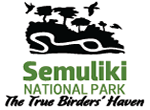[vc_row][vc_column width=”2/3″][vc_column_text]Riverbanks on the Uganda side range from 2 to 4 meters high, depending on the season. Flood pulses during March and September reshape access points. These seasonal changes influence where animals come to drink or forage. Vegetation density increases after high water retreats, especially around oxbow depressions.
Common visual signs include crocodile slides, otter tracks, and hippo trails leading into backwater channels. Moreover, visitors occasionally spot forest buffaloes approaching from thicker undergrowth, particularly near undisturbed edges. The river also attracts sitatunga during quiet midday periods.
Avian activity remains high. African fish eagles (Haliaeetus vocifer) perch along exposed tree limbs above bends. In addition, pied kingfishers and white-throated bee-eaters occupy sandy sections near insect hatches. Wading birds, including the striated heron, can be observed during low water periods.
Observation is typically done from clearings reached via the Kirumia Trail or ranger-assisted diversions. Field teams advise early arrival, as light angles are favourable between 07:00 and 10:00 hours. Direct sunlight during midday flattens contrast and reduces visibility into the channel.
The river segment supports several ecological transitions not present in the forest core. These include amphibian breeding sites and floating aquatic flora. Water parameters fluctuate seasonally, but dissolved oxygen remains moderate, supporting mid-level aquatic life.[/vc_column_text][/vc_column][vc_column width=”1/3″][vc_widget_sidebar sidebar_id=”shop-widget”][/vc_column][/vc_row]
